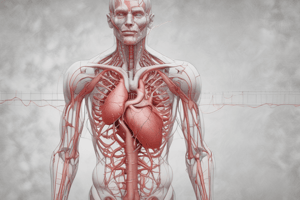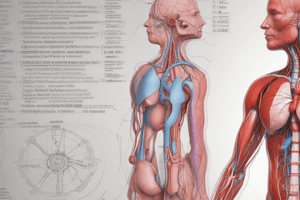Podcast
Questions and Answers
What is the primary function of the cardiovascular system?
What is the primary function of the cardiovascular system?
- Regulate body temperature
- Produce red blood cells
- Protect against infections
- Transport oxygen, carbon dioxide, waste products, nutrients, and hormones (correct)
Which vessels are responsible for carrying deoxygenated blood back to the heart?
Which vessels are responsible for carrying deoxygenated blood back to the heart?
- Aorta
- Superior and Inferior Vena cava (correct)
- Pulmonary veins
- Pulmonary arteries
Which side of the heart pumps blood to the lungs?
Which side of the heart pumps blood to the lungs?
- Posterior
- Right (correct)
- Anterior
- Left
Which of these is NOT a function of the circulatory system?
Which of these is NOT a function of the circulatory system?
What type of blood vessels carries blood away from the heart?
What type of blood vessels carries blood away from the heart?
How does the left side of the heart contribute to circulation?
How does the left side of the heart contribute to circulation?
Which vessels return blood to the right atrium?
Which vessels return blood to the right atrium?
Which of these elements is transported by the cardiovascular system?
Which of these elements is transported by the cardiovascular system?
Flashcards are hidden until you start studying
Study Notes
The Cardiovascular System
- The cardiovascular system is responsible for transporting oxygen, carbon dioxide, waste products, nutrients, and hormones throughout the body.
- It consists of the heart, blood vessels (arteries, veins, and capillaries), and blood.
Structure of the Heart
- The heart has major vessels that supply it with deoxygenated blood from the body.
- The heart also has major vessels that carry oxygenated blood away from the heart to the rest of the body.
Circulatory Systems
- The cardiovascular system is composed of two major circulatory systems: the right side and the left side of the heart.
Right Side of the Heart
- The right side pumps blood to the lungs through the pulmonary artery and pulmonary capillaries.
- It returns blood to the left atrium through the pulmonary veins.
Left Side of the Heart
- The left side pumps blood to the rest of the body through the aorta, arteries, arterioles, and systemic capillaries.
- It returns blood to the right atrium through the venules and great veins (Superior and Inferior vena cava).
Functions of the Circulatory System
- Carries blood throughout the body.
- Transports hormones, immune system components, coagulation molecules, enzymes, and more.
- Exchanges nutrients, waste products, and gases between blood vessels and tissues.
- Regulates blood pressure.
- Directs blood flow in blood vessels.
Studying That Suits You
Use AI to generate personalized quizzes and flashcards to suit your learning preferences.




